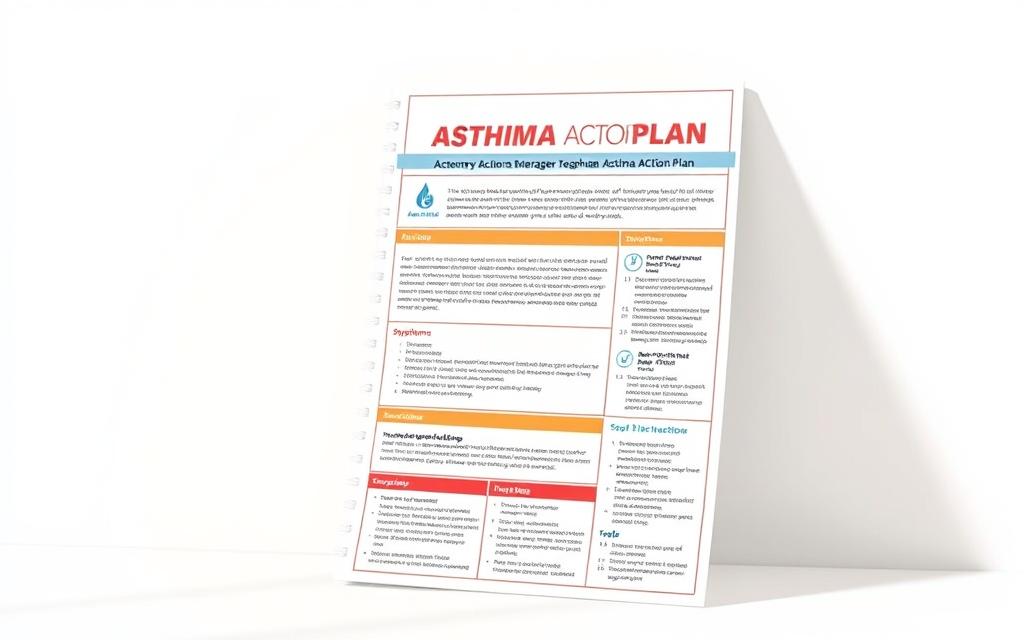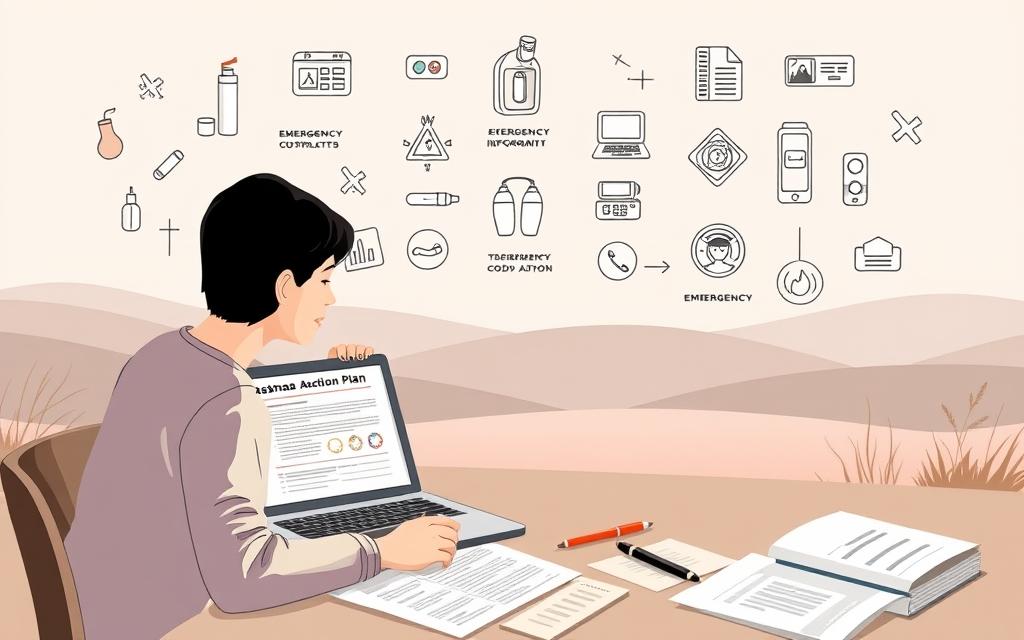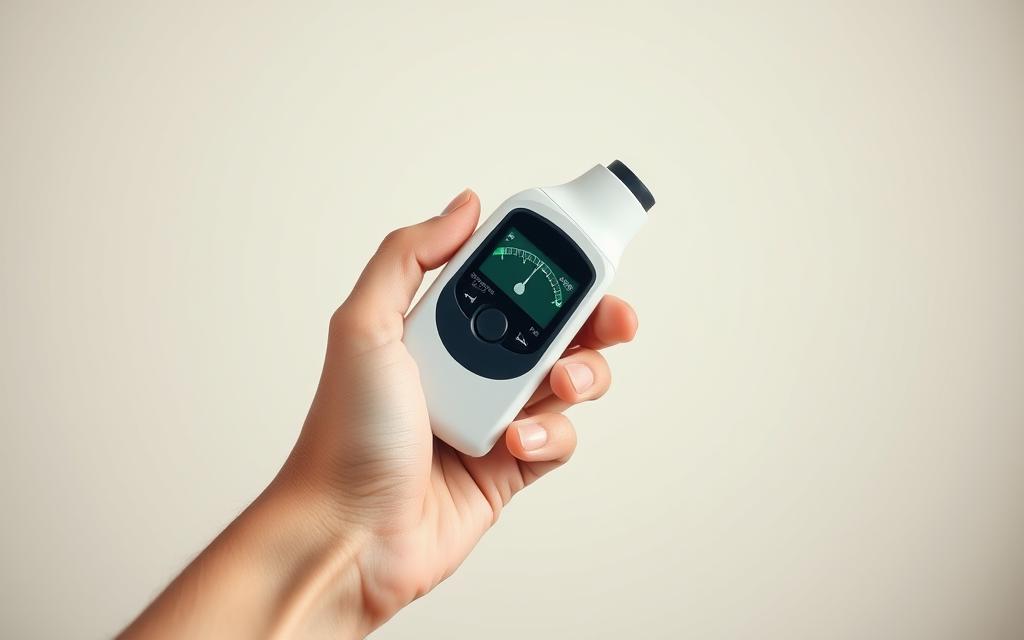Do you know that feeling when your chest tightens and breathing gets hard? It’s scary, especially if you have asthma. An emergency asthma action plan is like a safety net. It guides us through tough times.
By learning how to manage asthma, we take charge. We reassure our loved ones that we can handle an asthma attack. A good plan helps us share what to do in an emergency. This makes everyone feel safer and less worried.
Key Takeaways
- An emergency asthma action plan is essential for managing asthma flare-ups.
- Understanding the symptoms and proper medication is crucial for asthma attack relief.
- Personalized plans can provide clarity and guidance during emergencies.
- Involving healthcare providers enhances the effectiveness of an asthma action plan.
- Regular reviews of the action plan can adapt to changing needs.
- Everyone around us should be aware of our action plan for better support.
Understanding Asthma and Its Impact
Asthma is a chronic respiratory condition that affects millions. It causes inflammation and narrowing of the airways. This makes breathing hard, impacting our daily lives.
Understanding asthma helps us see how different symptoms can be. Especially during severe flare-ups.
Things like pollen, smoke, or pet dander can make asthma worse. Knowing what triggers your asthma is key to managing it. By avoiding these triggers and following treatment plans, we can live better lives.

Learning about asthma helps us manage it better. This knowledge lets us quickly spot and deal with severe symptoms. It also encourages us to take care of our health.
Managing asthma means using medication and making lifestyle changes. It helps us live healthier, symptom-free lives.
What is an Emergency Asthma Action Plan?
An emergency asthma action plan is a key tool for managing asthma. It outlines steps to take when symptoms worsen. This plan helps us spot and act on worsening symptoms quickly.
This plan includes important details like medication doses and when to take them. It’s crucial for people with asthma and those who care for them. It gives us the confidence to handle asthma emergencies effectively.
Creating our action plan should reflect our personal needs and triggers. Each plan is unique, but the goal is the same: to ensure we get the right care in emergencies. With our plan, we’re ready to tackle asthma challenges and keep ourselves safe.

Importance of Having a Personalized Action Plan
A personalized asthma emergency action plan is key to managing our health well. It takes into account our unique triggers, medications, and symptoms. This makes it easier to handle an asthma emergency.
Every person’s asthma is different. So, having a plan that fits us is crucial. It helps us tackle our specific needs effectively.
Having a plan tailored to us can make asthma treatment more effective. It teaches us what to do when symptoms get bad. This reduces stress during emergencies.
Studies show that personalized plans improve how we manage our asthma. They help us visit the emergency room less and avoid hospital stays.
We should work with our healthcare team to make our asthma action plan. This way, we can find the best ways to manage our asthma together. Following our plan makes us more confident in dealing with asthma, improving our daily lives.

| Benefits of a Personalized Asthma Action Plan | Impact on Health Management |
|---|---|
| Addresses individual asthma triggers | Reduces frequency of severe asthma attacks |
| Defines clear medication instructions | Improves adherence to prescribed treatments |
| Outlines specific actions for emergencies | Enhances readiness and confidence during an attack |
| Encourages regular monitoring | Supports proactive health management |
Components of an Effective Asthma Action Plan
An effective asthma action plan is key for managing asthma well. It helps us spot symptoms, keep track of medication, and act fast in emergencies. Here are the main parts to include for good asthma care.
Identifying Symptoms and Medication
Knowing asthma symptoms is the first step in managing it. Signs include shortness of breath, chest tightness, and wheezing. We must keep a detailed record of our medications, their doses, and when to take them.
This ensures we react quickly in emergencies. We use our rescue inhaler or other meds as needed.
Understanding the Zones: Green, Yellow, and Red
The zone system makes asthma management simpler. We divide symptoms into three zones:
| Zone | Symptoms | Action |
|---|---|---|
| Green | No symptoms; controlled asthma | Continue with regular medications |
| Yellow | Mild symptoms; coughing, wheezing | Use rescue inhaler and monitor closely |
| Red | Severe symptoms; difficulty breathing | Seek emergency care immediately |
Knowing these zones helps us respond right. This prevents severe attacks and keeps us safe. Good asthma plans empower us to handle our condition with confidence.

Developing Your Emergency Asthma Action Plan
Having a good plan is key when an asthma emergency strikes. Making a plan is a team effort. We need to work with healthcare providers to understand our needs. They help make sure our plan is strong and fits us perfectly.
Consulting with Healthcare Providers
Healthcare providers are essential in managing asthma. They help us understand our condition better. They guide us on how to use emergency medication and avoid triggers. Working with them makes our asthma care safer and more effective.
Customizing the Plan for Individual Needs
Our emergency asthma plan should match our health and life. We can do this by talking about our symptoms and medications with our providers. We should also include:
- Individual medication dosages
- Step-by-step instructions for managing flare-ups
- Contact information for our healthcare team
- Emergency contacts for family members and friends

Emergency Asthma Medication: What You Need to Know
It’s key to know about emergency asthma meds for good asthma care. These meds, like quick-relief bronchodilators, help right away with symptoms like wheezing and shortness of breath. Learning how to use inhalers well can make them work better.
It’s important to know the difference between rescue and long-term meds. Rescue meds quickly help during attacks, while long-term meds prevent them. Talking often with our doctors helps us see if our meds are working and makes changes as needed.

Keeping track of how we react to emergency meds is crucial. Writing down when and how bad symptoms are helps a lot in managing asthma. This info helps us make better choices about our meds and avoid big asthma attacks.
| Medication Type | Purpose | Examples |
|---|---|---|
| Rescue Medications | Relieve acute symptoms during an asthma attack | Albuterol, Levalbuterol |
| Long-term Control Medications | Prevent asthma symptoms and attacks | Inhaled corticosteroids, Leukotriene modifiers |
In short, we must focus on understanding and managing our emergency asthma meds well. This helps us deal with sudden asthma attacks better, keeping us healthy and happy. Being informed and organized helps us take charge of our asthma.
Recognizing Severe Asthma Symptoms
It’s important to know the warning signs of severe asthma symptoms. Spotting these signs helps us act fast and get the right help. Being ready can really help manage our asthma and keep us healthy.
Signs That Indicate a Need for Immediate Action
- Shortness of breath that is worsening or occurs at rest.
- Wheezing or coughing that is persistent and does not improve.
- Chest tightness that limits our ability to speak or carry out daily activities.
- Signs of bluish lips or fingernails, indicating insufficient oxygen.
- Declining peak flow meter readings indicating severe airway obstruction.
When to Seek Emergency Treatment
If we see severe asthma symptoms that don’t get better with our meds, we need to act fast. This includes:
- Experiencing an asthma attack that lasts longer than 20 minutes.
- Using a rescue inhaler more than twice in a week.
- Symptoms that progressively worsen despite following the action plan.
- Feeling unusually fatigued or unable to perform regular tasks.
Utilizing Peak Flow Meters for Monitoring
Peak flow meters are key asthma management tools for tracking our breathing health. They measure the fastest speed we can breathe out. This helps us see if our asthma is under control.
By using a peak flow meter every day, we can spot changes in our lungs. This lets us act fast when our breathing changes.
Using a peak flow meter means taking the same measurements every day. This makes it easier to see how our breathing is doing over time. Keeping a record of these numbers is important. It helps doctors see if our asthma is being well-managed.
| Peak Flow Meter Readings | Green Zone (Good Control) | Yellow Zone (Caution) | Red Zone (Danger) |
|---|---|---|---|
| Measurement Range | 80-100% of Personal Best | 50-79% of Personal Best | Below 50% of Personal Best |
| Action Required | No action needed; continue normal medications. | Use quick-relief medications; consider contacting a healthcare provider. | Seek emergency treatment immediately. |
Adding peak flow monitoring to our asthma care routine gives us more control. Knowing our numbers helps us handle our asthma better.

Emergency Response: What to Do During an Asthma Attack
When we have an asthma attack, knowing what to do can be lifesaving. First, we must stay calm. Getting anxious can make our symptoms worse. So, it’s important to breathe slowly and deeply.
Then, we should use our rescue medication. This inhaler is made to quickly ease asthma symptoms. It can really help us feel better fast.
If our symptoms don’t get better right away, we need to see a doctor. It’s key to tell others about our asthma and our plan for emergencies. This way, when we’re in trouble, help will come quickly.
Talking openly about our asthma helps others know how to help us. This is especially important when every second counts.

Tips for Managing Asthma During a Crisis
Managing asthma crises starts with being ready and quick to act. Knowing what triggers your asthma is key. Avoiding these can help prevent attacks.
Having an emergency kit with fast-acting medicines is crucial. Make sure it’s easy to find so you can act fast when needed.
Knowing the signs of an attack is vital. If you feel short of breath or wheeze, it’s time to take action. Use your peak flow meter to check how bad it is. Staying calm is also important to handle the situation better.
Talking to your doctor regularly keeps your asthma plan up to date. They can help you make it better. Following a plan during a crisis helps you know what to do.
When things get tough, breathe slowly. This helps control panic and stress, which can make breathing harder. Drinking enough water also helps keep airways clear.

Conclusion
A well-structured emergency asthma action plan is crucial for managing asthma, especially during acute episodes. Understanding our condition and tailoring our plans helps us face health crises with confidence. This preparation is essential for better asthma management during emergencies.
Regular visits to healthcare providers keep our plans up-to-date and effective. Monitoring tools help us watch our symptoms closely. By being proactive, we can control our asthma and live more active, fulfilling lives. Remember, being prepared greatly reduces risks and improves outcomes for emergency asthma plans.
FAQ
What is an emergency asthma action plan?
An emergency asthma action plan is a detailed guide for handling asthma attacks. It shows how to spot worsening symptoms and when to use certain medicines. This helps patients and their caregivers be ready.
Why is it important to have a personalized asthma action plan?
A personalized plan considers your specific triggers and symptoms. It makes emergency care more effective. This tailored approach can prevent severe attacks and improve health outcomes.
What are the key components of an effective asthma action plan?
A good plan lists symptoms, medication use, and emergency contacts. It also uses a color-coded system to track asthma control. This helps us respond quickly and effectively.
How can we recognize severe asthma symptoms?
Look out for signs like hard breathing, constant coughing, wheezing, tight chest, and trouble speaking. Spotting these early is key to managing asthma well.
What steps should we take during an asthma attack?
Stay calm and use rescue meds like bronchodilators during an attack. If symptoms don’t get better, seek medical help fast. Also, tell others about your asthma and your plan.
How can peak flow meters help with asthma management?
Peak flow meters measure breathing speed. They help track asthma control. Regular use lets us catch worsening symptoms early, helping us act fast.
What emergency asthma medications should we be familiar with?
Know your emergency meds, like bronchodilators. It’s important to understand the difference between these quick-acting meds and long-term control meds. They serve different roles in managing asthma.
How should we develop our emergency asthma action plan?
Work with healthcare providers to create a detailed, personalized plan. Regular updates based on your symptoms and triggers make it more effective.
What are some tips for managing asthma during a crisis?
Stay calm and follow your plan during a crisis. Communicate your needs and keep emergency meds handy. Regular health check-ups also help keep your asthma in check.
